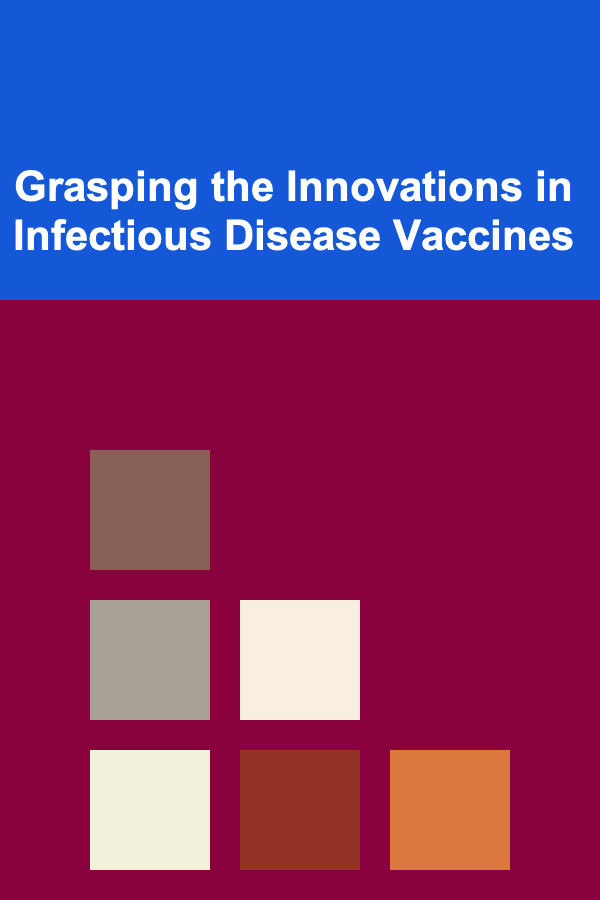
Grasping the Innovations in Infectious Disease Vaccines
ebook include PDF & Audio bundle (Micro Guide)
$12.99$9.99
Limited Time Offer! Order within the next:

Vaccines have long been a cornerstone of public health, dramatically reducing the incidence and severity of numerous infectious diseases. From the eradication of smallpox to the near-elimination of polio in many parts of the world, vaccines stand as a testament to the power of preventative medicine. However, the landscape of infectious diseases is constantly evolving, demanding continuous innovation in vaccine development. New pathogens emerge, existing pathogens develop resistance, and the complexities of the human immune system present ongoing challenges. Understanding and grasping the innovations in infectious disease vaccines is crucial for healthcare professionals, researchers, policymakers, and the general public alike. This article delves into the key advancements shaping the future of vaccines, exploring the underlying scientific principles, technological breakthroughs, and the challenges that lie ahead.
I. Traditional Vaccine Approaches: A Foundation for Innovation
Before exploring the cutting-edge innovations, it's essential to understand the traditional vaccine approaches that have paved the way. These methods, while still relevant today, provide a framework for appreciating the significance of newer technologies.
A. Live-Attenuated Vaccines
Live-attenuated vaccines contain weakened forms of the pathogen. These weakened viruses or bacteria can still replicate, albeit slowly, triggering a strong and long-lasting immune response. The attenuation process typically involves culturing the pathogen under conditions that favor mutations that reduce its virulence while preserving its ability to stimulate immunity. Examples include the measles, mumps, rubella (MMR) vaccine, the varicella (chickenpox) vaccine, and the oral polio vaccine (OPV).
Advantages:
- Strong and long-lasting immunity, often requiring only one or two doses.
- Broad immune response, stimulating both humoral (antibody-mediated) and cellular (T-cell-mediated) immunity.
Disadvantages:
- Potential for reversion to a virulent form, although rare.
- Not suitable for immunocompromised individuals or pregnant women.
- Requires careful storage and handling due to the presence of live organisms.
B. Inactivated Vaccines
Inactivated vaccines contain pathogens that have been killed through heat, radiation, or chemicals. These vaccines are safer than live-attenuated vaccines because they cannot replicate or cause disease. However, they generally elicit a weaker immune response and require multiple doses (booster shots) to achieve long-lasting protection. Examples include the inactivated polio vaccine (IPV), the influenza vaccine, and the hepatitis A vaccine.
Advantages:
- Safe for immunocompromised individuals and pregnant women.
- No risk of reversion to a virulent form.
- Generally easier to store and handle compared to live-attenuated vaccines.
Disadvantages:
- Weaker immune response compared to live-attenuated vaccines.
- Requires multiple doses (booster shots) for long-lasting protection.
- May not elicit as broad an immune response as live-attenuated vaccines.
C. Subunit, Recombinant, Polysaccharide, and Conjugate Vaccines
These vaccines utilize specific components of the pathogen, rather than the whole organism. This approach reduces the risk of adverse reactions and allows for targeted immune responses.
- Subunit vaccines: Contain specific protein antigens from the pathogen. Examples include the hepatitis B vaccine and the acellular pertussis vaccine.
- Recombinant vaccines: Use genetic engineering to produce pathogen proteins in a host cell, such as yeast or bacteria. The produced proteins are then purified and used in the vaccine. The human papillomavirus (HPV) vaccine is a prime example.
- Polysaccharide vaccines: Contain polysaccharide molecules from the bacterial capsule. These vaccines are effective against encapsulated bacteria, such as Streptococcus pneumoniae. However, polysaccharide vaccines often do not elicit a strong immune response in young children.
- Conjugate vaccines: Link polysaccharides to a carrier protein, such as tetanus toxoid or diphtheria toxoid. This conjugation process enhances the immune response in infants and young children, making these vaccines more effective against encapsulated bacteria. The Haemophilus influenzae type b (Hib) vaccine is a classic example.
Advantages:
- Generally safe and well-tolerated.
- Targeted immune response, reducing the risk of adverse reactions.
- Conjugate vaccines are highly effective in infants and young children.
Disadvantages:
- May require multiple doses (booster shots) for long-lasting protection.
- The immune response may not be as broad as that elicited by live-attenuated vaccines.
- Can be more complex and expensive to manufacture than other types of vaccines.
II. Emerging Vaccine Technologies: A New Era of Immunization
The limitations of traditional vaccine approaches, coupled with the emergence of novel pathogens and the desire for more effective and efficient vaccines, have driven the development of innovative technologies. These technologies are revolutionizing the field of vaccinology, offering the potential to address previously intractable challenges.
A. Nucleic Acid Vaccines (DNA and mRNA Vaccines)
Nucleic acid vaccines, specifically DNA and mRNA vaccines, represent a groundbreaking approach to immunization. These vaccines deliver genetic material encoding pathogen antigens directly into the host cells. The host cells then use this genetic information to produce the antigen, triggering an immune response.
- DNA vaccines: Deliver DNA plasmids containing the gene encoding the target antigen into the host cell nucleus. The host cell's machinery then transcribes the DNA into mRNA, which is subsequently translated into protein.
- mRNA vaccines: Deliver mRNA molecules encoding the target antigen directly into the host cell cytoplasm. The host cell's ribosomes then translate the mRNA into protein.
Advantages:
- Rapid development and manufacturing, allowing for quick responses to emerging outbreaks.
- Relatively inexpensive to produce compared to traditional vaccines.
- Safe, as they do not involve the use of live pathogens or viral vectors.
- Can elicit both humoral and cellular immune responses.
- mRNA vaccines, in particular, do not need to enter the cell nucleus, potentially simplifying the process and reducing the risk of insertional mutagenesis (associated with DNA vaccines, although this is generally considered very low).
Disadvantages:
- Historically, DNA vaccines have shown lower immunogenicity in humans compared to other vaccine types. However, technological advancements are addressing this issue.
- mRNA vaccines require specialized storage and handling due to their instability, although formulations and delivery systems are continuously improving.
- Long-term safety data is still being gathered for widespread use.
- Public perception and acceptance can be influenced by concerns about genetic modification, although these vaccines do not alter the host's DNA.
Examples: The mRNA vaccines developed by Pfizer-BioNTech and Moderna against COVID-19 are prime examples of the success of this technology. Research is also ongoing for mRNA vaccines against influenza, Zika virus, and other infectious diseases. DNA vaccines have been approved for veterinary use and are being investigated for human use against various diseases.
B. Viral Vector Vaccines
Viral vector vaccines utilize harmless viruses as vehicles to deliver genetic material encoding pathogen antigens into host cells. These viral vectors are typically modified to be replication-deficient, meaning they cannot cause disease in the host. Upon entering the cell, the viral vector delivers the gene encoding the antigen, which is then expressed by the host cell, triggering an immune response.
Advantages:
- Can elicit strong and long-lasting immune responses.
- Can stimulate both humoral and cellular immunity.
- Well-established technology, with several viral vector vaccines already approved for human use.
Disadvantages:
- Pre-existing immunity to the viral vector can reduce vaccine efficacy.
- Potential for adverse reactions to the viral vector itself.
- Manufacturing can be more complex and expensive than some other vaccine types.
Examples: The adenovirus-based COVID-19 vaccines developed by Johnson & Johnson and AstraZeneca are examples of viral vector vaccines. An Ebola vaccine also utilizes a viral vector approach.
C. Peptide Vaccines
Peptide vaccines contain short peptide sequences derived from pathogen antigens. These peptides are designed to stimulate specific T-cell responses, which are crucial for clearing infected cells and providing long-lasting immunity. Peptide vaccines often require the addition of adjuvants to enhance the immune response.
Advantages:
- Highly specific immune response, reducing the risk of off-target effects.
- Relatively easy and inexpensive to manufacture.
- Can be designed to target specific T-cell epitopes.
Disadvantages:
- Can be difficult to identify peptides that elicit a strong and protective immune response in a broad population due to HLA (human leukocyte antigen) variability.
- Often require the addition of potent adjuvants to enhance immunogenicity.
- May not elicit as broad an immune response as other vaccine types.
Examples: Peptide vaccines are being investigated for the treatment and prevention of cancer and chronic viral infections, such as HIV and hepatitis C. While no peptide vaccine is currently licensed for the prevention of infectious disease, research continues.
D. Virus-Like Particle (VLP) Vaccines
Virus-like particles (VLPs) are multi-protein structures that resemble viruses but lack the viral genetic material, rendering them non-infectious. These VLPs are highly immunogenic because they mimic the structure of the virus, stimulating a strong immune response. VLPs can be produced by expressing viral structural proteins in host cells, such as yeast or insect cells.
Advantages:
- Safe and well-tolerated.
- Highly immunogenic, eliciting strong antibody responses.
- Can be produced in large quantities.
Disadvantages:
- May be more expensive to manufacture than some other vaccine types.
- The immune response may not be as broad as that elicited by live-attenuated vaccines.
Examples: The HPV vaccine (Gardasil and Cervarix) is a highly successful example of a VLP vaccine. VLP vaccines are also being investigated for influenza and other infectious diseases.
E. Self-Amplifying RNA (saRNA) Vaccines
Self-amplifying RNA (saRNA) vaccines are a sophisticated advancement over conventional mRNA vaccines. saRNA incorporates a sequence from an alphavirus that allows the RNA to replicate within the host cell cytoplasm. This amplification process results in the production of a greater amount of antigen, leading to a stronger and more prolonged immune response at a lower dose. This enhanced potency can be particularly advantageous for diseases where a robust and durable immune response is crucial.
Advantages:
- Potentially higher immunogenicity compared to conventional mRNA vaccines, allowing for lower doses and reduced side effects.
- Prolonged antigen expression, leading to a more durable immune response.
- Rapid development and manufacturing capabilities.
Disadvantages:
- More complex to manufacture than conventional mRNA vaccines.
- Stability and delivery challenges similar to mRNA vaccines.
- Long-term safety data is still being gathered.
Examples: While no saRNA vaccines are currently licensed, several are in clinical development for diseases such as influenza, rabies, and COVID-19. The ongoing research suggests a promising future for this technology.
III. Adjuvants: Enhancing Vaccine Immunogenicity
Adjuvants are substances that are added to vaccines to enhance the immune response. They work by activating innate immune cells, such as dendritic cells and macrophages, which then present the antigen to T cells and B cells, leading to a stronger and more long-lasting immune response. The type of adjuvant used can significantly impact the efficacy and safety of a vaccine.
A. Traditional Adjuvants
Traditional adjuvants include aluminum salts (alum), which have been used in vaccines for decades. Alum is generally safe and well-tolerated but elicits a primarily antibody-mediated immune response. Other traditional adjuvants include squalene-based emulsions, such as MF59, which is used in some influenza vaccines.
B. Novel Adjuvants
Novel adjuvants are designed to stimulate more potent and targeted immune responses. These adjuvants include toll-like receptor (TLR) agonists, which activate innate immune cells by binding to TLRs. Other novel adjuvants include saponins, such as QS-21, and liposomes. These newer adjuvants often aim to stimulate both humoral and cellular immunity, providing broader protection against infectious diseases.
Examples: MPL (monophosphoryl lipid A), a TLR4 agonist, is used in some HPV vaccines. AS01, a combination of MPL and QS-21, is used in the Shingrix vaccine for shingles. Research continues on developing even more effective and safer adjuvants.
IV. Challenges and Future Directions
Despite the remarkable progress in vaccine development, significant challenges remain. Addressing these challenges will be crucial for developing vaccines against a wider range of infectious diseases and improving the efficacy and accessibility of existing vaccines.
A. Emerging and Re-Emerging Infectious Diseases
The emergence of new pathogens, such as SARS-CoV-2, and the re-emergence of old ones, such as Zika virus and dengue fever, pose a constant threat to global health. Rapid vaccine development platforms, such as mRNA technology, are crucial for responding to these outbreaks quickly and effectively. Furthermore, research into broad-spectrum vaccines that can provide protection against multiple strains or variants of a pathogen is essential.
B. Vaccine Hesitancy
Vaccine hesitancy, the reluctance or refusal to vaccinate despite the availability of vaccines, is a growing concern in many parts of the world. Misinformation and distrust in science can fuel vaccine hesitancy, leading to outbreaks of preventable diseases. Effective communication strategies, building trust with communities, and addressing concerns about vaccine safety are crucial for combating vaccine hesitancy.
C. Global Vaccine Equity
Ensuring equitable access to vaccines around the world is a major challenge. High-income countries often have greater access to vaccines than low- and middle-income countries, leading to disparities in disease burden and mortality. International collaborations, technology transfer, and increased funding for vaccine development and distribution are essential for achieving global vaccine equity.
D. Improving Vaccine Delivery
Developing more efficient and convenient vaccine delivery methods can improve vaccine coverage and reduce the burden on healthcare systems. Needle-free injection systems, oral vaccines, and thermostable vaccines that do not require refrigeration are examples of innovations that can improve vaccine delivery in resource-limited settings.
E. Personalized Vaccines
The future of vaccinology may involve personalized vaccines tailored to an individual's immune profile. This approach could improve vaccine efficacy and reduce the risk of adverse reactions. Advances in genomics and immunology are paving the way for the development of personalized vaccines against cancer and infectious diseases.
V. Conclusion
The field of infectious disease vaccines is undergoing a period of unprecedented innovation. From the groundbreaking mRNA technology to the development of novel adjuvants and delivery methods, the future of vaccinology is bright. Grasping these innovations requires a commitment to understanding the underlying scientific principles, following the latest research findings, and engaging in informed discussions about the benefits and challenges of vaccination. By embracing innovation and addressing the challenges that lie ahead, we can unlock the full potential of vaccines to protect global health and prevent the spread of infectious diseases. Continuous investment in research, development, and implementation of new vaccine technologies is crucial to safeguard future generations from the ever-evolving threat of infectious diseases.

Beyond the Firewall: Advanced Techniques in Cybersecurity Analysis
Read More
How to Create a Car Emergency Plan for Unexpected Situations
Read More
How to Integrate Smart Home Technology into Your Renovation
Read More
How to Make Money Online as a Payroll Specialist: 10 Actionable Ideas
Read More
How to Generate Leads for Your Small Business
Read More
Exploring Gene Therapy for Blindness: A Comprehensive Overview
Read MoreOther Products

Beyond the Firewall: Advanced Techniques in Cybersecurity Analysis
Read More
How to Create a Car Emergency Plan for Unexpected Situations
Read More
How to Integrate Smart Home Technology into Your Renovation
Read More
How to Make Money Online as a Payroll Specialist: 10 Actionable Ideas
Read More
How to Generate Leads for Your Small Business
Read More